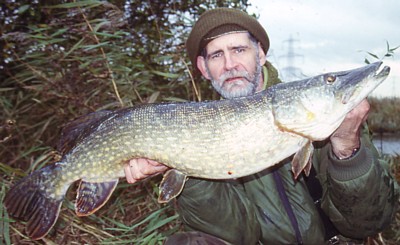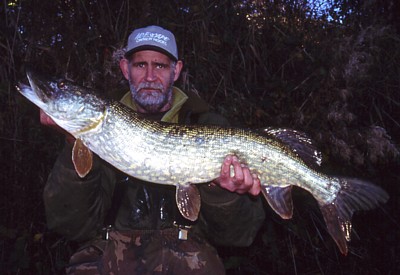 This
is the first of a series of five short articles about pike rigs. While the subject
(and some of the rigs!) might seem basic, I hope there will be something in them
to interest, or provoke thought or debate amongst pikers of all levels of experience.
The aim is to look at how rigs work, and how they can be improved upon. I don't
expect anyone to take everything I say as gospel, or to agree with everything,
all I will say is that this is how I see it and how I think it works for me. If
your experience differs, why not write an article about it? By sharing our thoughts
we can all come to a better understanding of the 'art' of pike fishing.
This
is the first of a series of five short articles about pike rigs. While the subject
(and some of the rigs!) might seem basic, I hope there will be something in them
to interest, or provoke thought or debate amongst pikers of all levels of experience.
The aim is to look at how rigs work, and how they can be improved upon. I don't
expect anyone to take everything I say as gospel, or to agree with everything,
all I will say is that this is how I see it and how I think it works for me. If
your experience differs, why not write an article about it? By sharing our thoughts
we can all come to a better understanding of the 'art' of pike fishing.
I
have written in the past that I don't suffer from the dropped run phenomenon as
much as other people seem to do. Even when fishing on pressured waters. Sometimes
I wonder if I am just a crap piker, as I don't appear to get the same number of
follows from big fish as some other anglers when I am lure fishing! Is it me out
of step or them?
One
reason I think I don't get dropped runs to any degree is because I don't look
at my bite detection and terminal rig as separate entities. The whole thing from
bait to indicator should be viewed as a system - no matter what method is being
used. Taking this overview you might well end up using different approaches to
bite detection with different rigs.
So
in this odyssey through the world of my pike rigs this is the approach I shall
start out by looking at the most popular, and almost universally applicable, bite
indicator; the drop-back indicator. I prefer to call it a drop-back rather than
a drop-off because there will be times when it won't drop off! Even when using
rigs that look like they can't give you slack line takes you can still get them.
More of that later, but first of all a few words about the design of indicator
to use, and how to set them up correctly.
For
a start there seems to be a misconception that solid arm drop-back indicators
are more sensitive than those with flexible arms. I fail to see how this can be
the case if both are set up properly, and I actually prefer flexible arms myself,
as it is easier to see a slack line take when the arm, or cord, takes on a curve.
With a rigid arm you are looking to see a change in angle of the arm, which is
harder to detect visually. Admittedly, most people who use drop-back indicators
these days don't watch them all the time, and rely (sometimes too much) on an
audible indicator on their front rod rest to alert them to takes.
Drop-back
alarms which attach to the rear rod rest are still popular, and the principles
that apply to setting up a plain indicator also apply to setting up these alarms.
Unfortunately, in my experience, some are made in such a way that they cannot
be set up with the same degree of efficiency as a plain indicator.
No
matter what style of indicator you are using the setting up process is pretty
much the same. After casting out take up all the slack in the line. If fishing
at long range, more so when there is a strong cross wind blowing, this can take
some time, so make sure you are aware of this.
 With
the line tight, or nearly so, open the bale arm and pull a coil of line from the
spool. Place this in the line clip of the indicator. Now you have to set the indicator.
The easiest way of doing this with a drop-back that is attached to the rear bankstick
by a Terry clip is to slide the indicator down the bankstick until the line tightens.
Alternatively turn the spool of the reel to tighten the line. Take your time over
this. Sometimes, many times in fact, the line will pull out of the clip as you
try to set everything up. Close the bale arm, take up the slack again and start
over. Not only will setting your indicators up correctly make them more efficient
it will, if you are using a front alarm, cut down on the false bleeps you will
get. Don't aim to get it nearly right, aim for perfection. I am not one for perfection
as a rule, but when setting up my bite indicators I am.
With
the line tight, or nearly so, open the bale arm and pull a coil of line from the
spool. Place this in the line clip of the indicator. Now you have to set the indicator.
The easiest way of doing this with a drop-back that is attached to the rear bankstick
by a Terry clip is to slide the indicator down the bankstick until the line tightens.
Alternatively turn the spool of the reel to tighten the line. Take your time over
this. Sometimes, many times in fact, the line will pull out of the clip as you
try to set everything up. Close the bale arm, take up the slack again and start
over. Not only will setting your indicators up correctly make them more efficient
it will, if you are using a front alarm, cut down on the false bleeps you will
get. Don't aim to get it nearly right, aim for perfection. I am not one for perfection
as a rule, but when setting up my bite indicators I am.
Now,
as the name drop-back indicator suggests, these indicators should be capable of
dropping back, allowing the line to pass freely through the clip which holds them
on the line. The clip should not grip the line, and since braid has become popular
for bait fishing this has become more and more of a concern. I think it is the
thinness, allied with the texture and softness, of braid that can make it prone
to getting wedged in unsuitable line clips. Mono being hard, comparatively thick,
and smooth is less prone to this problem.
Back
in the old days when we had to make our own indicators I made my clips from large
hair grips with beads glued on each prong. These were pushed trough a table tennis
ball and a length of fly line backing tied to the loop of the clip, the other
end going to a Terry clip. Later, I advanced to the early adjustable Gardner clips
with the brass thumbscrew adjustment, which were quite good, but the Gardner Free-Flow
clips, were a big improvement. I have more recently (in a strangely cyclical reversion)
been using some stainless steel Nash clips with ball ends - reminiscent of the
old hair grip/bead clips! The ball ended clips seem to be the best option for
use with braid, and I have heard good reports of the Solar version. It is worth
taking the effort to replace poor clips with better ones if your indicators don't
perform too well.
Just
as I don't believe rigid arms offer any real advantages over flexible ones, I
am not convinced that heavy indicator heads are essential. Indeed, I think bobbins
on drop-back indicators can be too heavy. So long as they have free flowing clips
most heads will indicate slack line takes, the table tennis balls certainly did
the job. If the head is too heavy it can cause problems getting the line tight
enough to set the indicator properly, as its weight will keep dragging the rig
out of position, or require the clip to be adjusted so tightly that it can't be
pulled from the line!
Whatever
your drop-back indicator type it should be set so the only movement it can make
is downwards. The whole point of this type of indicator is that it keeps the line
from spilling off the open spool, until the split second the bait is moved. At
which point it should either drop free of the line if the pike moves away from
the rod, or drop back, sliding down the line, if a pike moves the bait towards
the rod. You should not be looking for preliminary indications of a run by having
the indicator hanging on a slack line. This might sound obvious to most of you,
but I still see loads of pikers fishing with their drop-back indicators set as
if they were bream fishing!
When
setting the indicator there is no need to position the bobbin of the indicator
anywhere in particular. You don't have to have it directly under, and touching,
the spool of the reel, for example - although this position does give a good visual
reference point for detecting small movements. If the whole set-up is under maximum
tension the bobbin can only move one way, downwards (either as it falls free of
the line, or as the line slackens and it slides down the line) no matter where
it is positioned. The only exception to this is if using a drop-back alarm that
relies on a mercury tilt switch, or a cam lever action. The bobbins of these alarms
should be aligned so that the minimum downward movement activates the buzzer,
and no upward movement is possible. In most cases this means they should be horizontal.
Setting
up rear alarms correctly will depend on the design of the alarm, but the two principles
of sliding the alarm up or down the rear rest, and rotating the spool of the reel,
can both be used. Mercury tilt alarms only sound when the head moves downwards
from the horizontal, so there must be no scope for upward movement. Cam action
alarms usually sound on an upward movement as well as a downward one. The most
sensitive rear alarms, which aren't currently available commercially, involve
an arm attached to a micro-switch which is closed by the tension in the rig. A
slight release in tension enables the micro-switch to spring open and sound the
alarm. Such sensitivity doesn't come without a downside, and in this instance
it is that these alarms can be too sensitive to use with rigs involving surface
floats. But I'll be returning to those rigs later.
Whatever
your indicator or alarm take the time and trouble to set it up precisely. If fishing
at range you might find that it takes a minute or two for the slack to go completely
out of the line after you have clipped the bobbin on. Don't just leave it, go
back and reset the indicator. Not only will your indication be improved, reducing
the chances of a pike swallowing the bait before registering an indication, but
the chances of dropped runs occurring will be reduced too.
It
should be apparent that you can only set your indicators up as described above
if your rigs fulfil certain parameters. As already hinted at, if your rig is too
light for the bobbin, the whole set up will be out of balance. I learned this
the time I tried fishing freelined deadbaits in a gale, using very heavy indicators.
The bobbins kept dropping back, so I retightened the line and clipped them back
so often the baits ended up almost under my rod tips. That was the day I gave
up on freelined deadbaits! No, if you want really effective bite indication you
have to have weight on the line to tighten up to, and you need at least an ounce
and a half, even at close range. Two ounces is better still, and essential once
you start casting over fifty yards or fishing in conditions that can drag baits
out of position. Match the amount of weight you need to the prevailing wind or
flow and bite detection efficiency will be maintained, as will presentation -
because you will keep your baits in the place you want them.
In
part
two I start to look at the rigs that I use, kicking off with the most
widely used rig of all, the leger.



